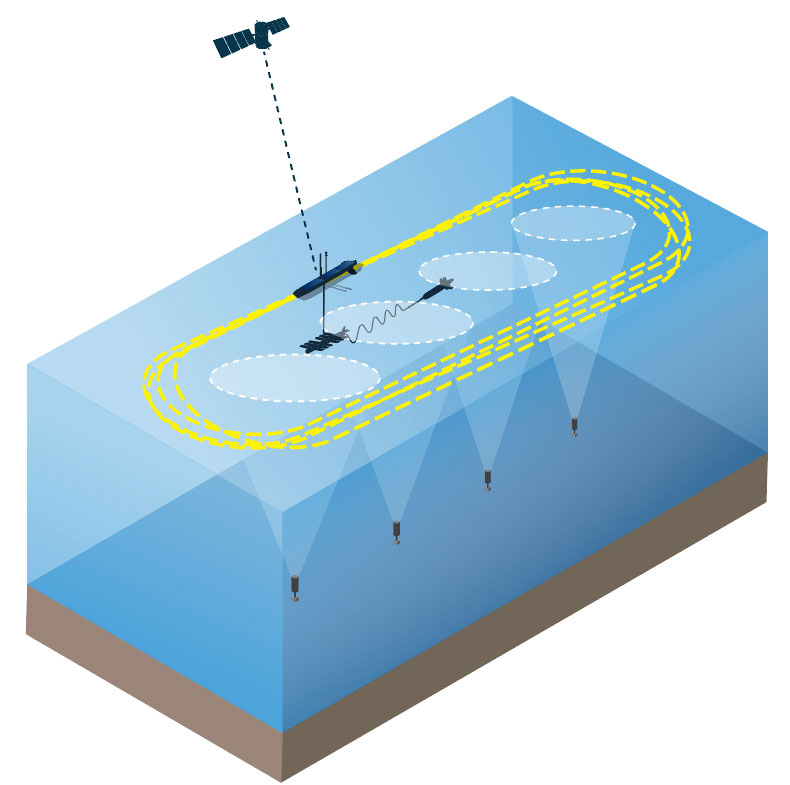Wired or Wireless – Networking and Harvesting Subsea Data
Liquid Robotics — June 29, 2017
Networking systems or sharing data while working underwater is difficult and expensive. For those of us who don’t work around the ocean or underwater, it can be hard to visualize this. Radio signals, the basis of WiFi, and seawater don’t mix well (think short range). Instead, many undersea operations rely on acoustic communications, as sound waves travel well through the water. In fact, sound travels approximately 5x faster below the surface of the water versus above it. Whales songs that occur at low frequencies can travel 1000s of miles at the right depth (in the sound channel).
The alternative to acoustic communication methods, is cable-based or wired communication. Ironically, wires power our wireless communication today. Roughly 99% of all transoceanic Internet data goes through submarine cables. Of course, many government and science projects and sensors rely on submarine cables. Examples include, the Cabled Axial Seamount in the Northwest of the US or the Japanese sea-floor observatory called DONET-2, which cost over $100 million. One high-tech benchmark for costs is the 9,000 km FASTER cable which Google and a consortium of Asian telecom players put down at a cost of roughly $300 million USD ($1M for 30km of cable).
The range and domain of cabled subsea systems is small and limited (relative to ocean areas of interest around the word). Subsea sensors and underwater autonomous vehicles (UAVs) offer ways for us to gather data from extended areas of the ocean and to serve a range of needs from the study of ocean habitats to public safety (seismic monitoring). Yet, the deployment and use of subsea sensors and other underwater systems has been limited due to costs, complexity, and the trade-offs between real-time and interim data. Getting data from battery-powered, subsea assets uses precious power, and requires a measured approach to data retrieval. Ships and buoys are traditionally used to harvest data, but this approach limits deployment options, mission flexibility, and increases costs. Autonomous, unmanned surface vehicles (USVs) that can operate over long durations (months) change this paradigm and open doors to new capabilities and systems across the science, energy, and defense business sectors.
As I mentioned earlier, many undersea operations depend upon acoustics as sound wave propagate well through sea water. Using sound for undersea telemetry and positioning has been well established with decades of development, but the tools to harvest data from these sensors have been limited until more recently. Unmanned surface vehicles have a natural role linking acoustic communications of the subsea with the radio communications of air and space.
With its nearly unlimited endurance the Wave Glider makes a natural choice to support acoustic telemetry connections. It provides a “gateway” between undersea systems and the potent radio spectrum in the atmosphere, which provides positioning, and data access. While developing and deploying Wave Gliders for gateway missions, a wide range of conditions have been experienced. Communications in depths of 4000 to 5500m with slant ranges of 5600m to 6300m (e.g., 750m to 3km watch circles) have been observed.

There are many providers of acoustic systems for USVs and UAVs and most of the leading choices have been successfully installed and demonstrated on Wave Gliders. Likewise, a large variety of applications have been evaluated by Liquid Robotics partners and customers including the following:
- Collection of data from seafloor sensors in offshore oil fields
- Relay of tsunami warning buoy signals
- New seafloor seismology methods
- Science investigations with other unmanned maritime vehicles.
If you’re interested in more details, the following white paper, which we presented at MAST 2017 – Asia summarizes and cites Wave Glider missions to support new, cutting edge applications from researchers at Scripps Institute of Oceanography and Monterey Bay Aquarium Research Institute (MBARI).

